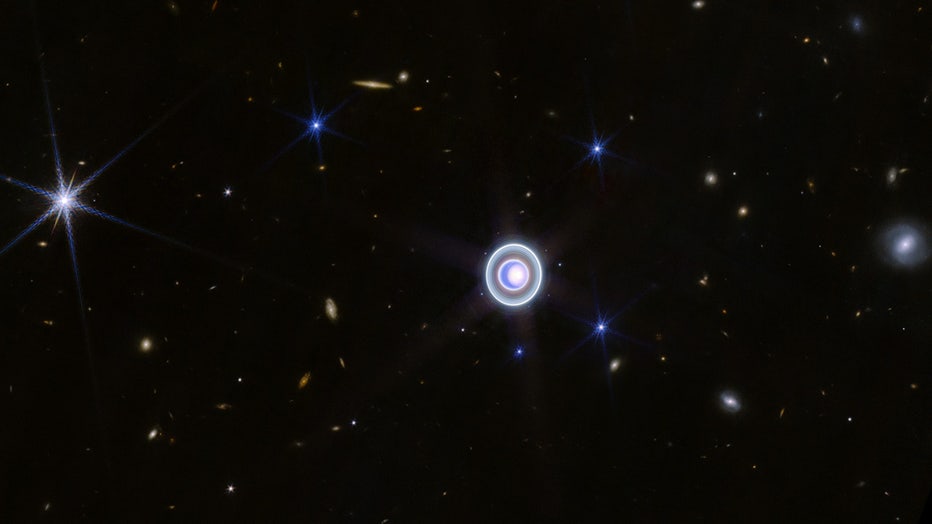NASA’s Webb telescope: ‘Ring’ in the holidays with newest image of Uranus

FILE - This image of Uranus from NIRCam (Near-Infrared Camera) on NASA’s James Webb Space Telescope exquisitely captures Uranus’s seasonal north polar cap and dim inner and outer rings. This Webb image also shows 9 of the planet’s 27 moons – clockwis (NASA, ESA, CSA, STScI)
NASA’s James Webb Space Telescope captured a dynamic image of Uranus just in time to "ring" in the holidays.
The glowing ice giant was captured in exquisite detail and Webb actually managed to get a glimpse at Uranus’ most elusive ring, Zeta, which can be seen as the faintest ring closest to the blue planet.
What’s more, Webb was able to spot the planet’s 27 known moons.

FILE - Annotated wide-field compass image of Uranus with some of its 27 moons and a few prominent stars (with characteristic diffraction spikes) labelled. (NASA, ESA, CSA, STScI)
Compared to the image that Webb captured of Uranus earlier this year, the planet’s north polar cloud cap is strikingly visible, as well as a few storms near and below the southern border of the cap.
"With Webb’s unparalleled infrared resolution and sensitivity, astronomers now see Uranus and its unique features with groundbreaking new clarity. These details, especially of the close-in Zeta ring, will be invaluable to planning any future missions to Uranus," NASA said.

FILE - This wide-field image of Uranus from NIRCam (Near-Infrared Camera) on NASA’s James Webb Space Telescope shows the planet amid a smattering of distant background galaxies. This image also includes 14 of the planet’s 27 moons: Oberon, Titania, U (NASA, ESA, CSA, STScI)
About Uranus
Uranus was discovered in 1781 by astronomer William Herschel who originally wanted to name the planet Georgium Sidus, after King George III, according to NASA.
The seventh planet from the sun is unique because it rotates on its side at about a 90-degree angle.
This angle causes extreme seasons on Uranus since the planet’s poles experience several years of constant sunlight and an equal number of years in constant darkness.
It takes Uranus about 84 Earth years to orbit the sun and takes about 17 hours to make a full rotation.
Uranus is known as an ice giant because of its chemical makeup.
"Most of its mass is thought to be a hot, dense fluid of ‘icy’ materials – water, methane, and ammonia – above a small rocky core," according to NASA.
Of Uranus’ 13 rings, nine are considered the main rings and two are the fainter dusty rings which weren’t discovered until the 1986 flyby by Voyager 2.
The rings have been categorized into two sets and most have either been numbered or named.
They are called Zeta, 6, 5, 4, Alpha, Beta, Eta, Gamma, Delta, Lambda, Epsilon, Nu, and Mu.
This story was reported from Los Angeles.

